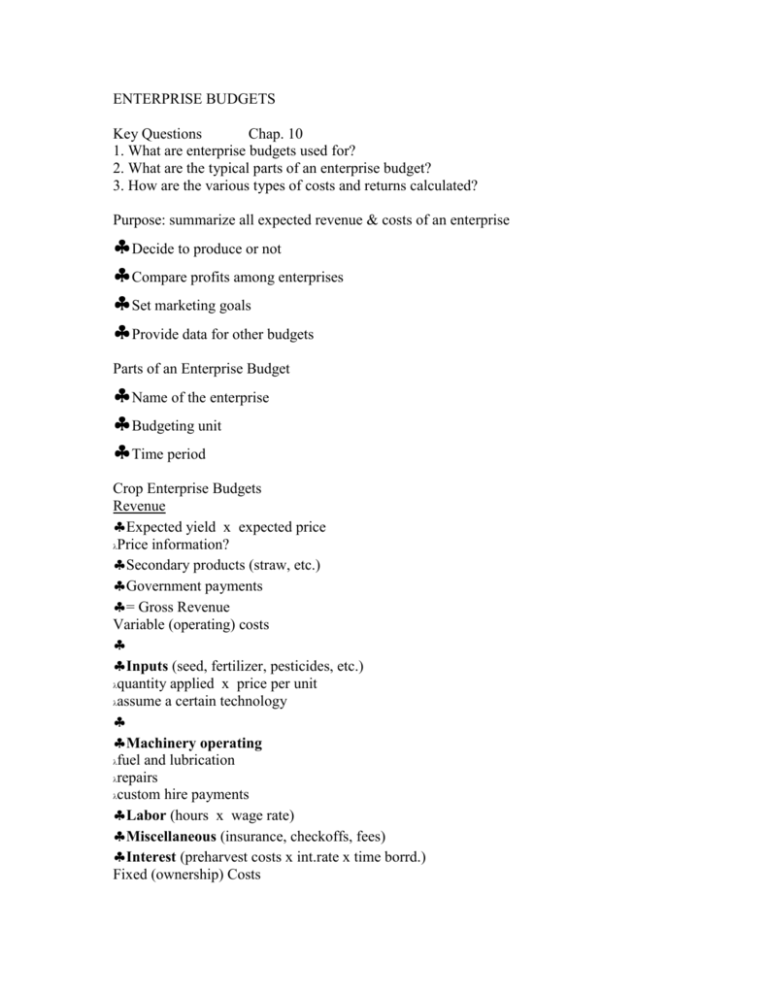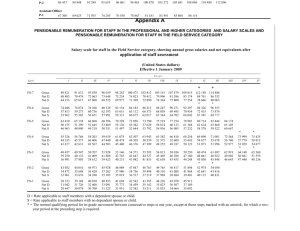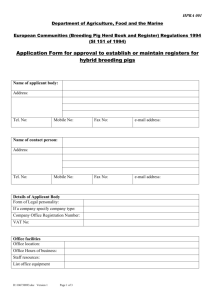ENTERPRISE BUDGETS
advertisement

ENTERPRISE BUDGETS Key Questions Chap. 10 1. What are enterprise budgets used for? 2. What are the typical parts of an enterprise budget? 3. How are the various types of costs and returns calculated? Purpose: summarize all expected revenue & costs of an enterprise Decide to produce or not Compare profits among enterprises Set marketing goals Provide data for other budgets Parts of an Enterprise Budget Name of the enterprise Budgeting unit Time period Crop Enterprise Budgets Revenue Expected yield x expected price Price information? Secondary products (straw, etc.) Government payments = Gross Revenue Variable (operating) costs Inputs (seed, fertilizer, pesticides, etc.) quantity applied x price per unit assume a certain technology Machinery operating fuel and lubrication repairs custom hire payments Labor (hours x wage rate) Miscellaneous (insurance, checkoffs, fees) Interest (preharvest costs x int.rate x time borrd.) Fixed (ownership) Costs Machinery ownership depreciation interest insurance and housing lease payments Land cash rent payment land market value x % rate of return •plus upkeep and property taxes Storage bins, silos, dryers, etc. Depreciation, interest, upkeep Summary Total costs = Gross margin = Profit = variable costs + fixed costs gross revenue – variable costs gross revenue – total costs gross margin – fixed costs or Other Terminology Gross Income (same as Gross Revenue) Return over Variable Costs Net Return or Return over All Costs Profit and Return to Management (same as Gross Margin) (same as Profit) Other Terms Variable costs = operating costs, direct costs Fixed costs = ownership costs, overhead Gross margin = return over variable costs Profit = return over all costs = return to management Breakeven Selling Prices To cover Total Costs = (total costs - other income) / yield To cover Variable Costs = (variable costs - other income) / yield Special Considerations in Crop Budgets If an after-harvest time selling price is used, include costs of storage, too, i.e. bins, electricity, spoilage losss Double-cropping: allocate annual fixed costs (land, machinery) between 2 crops Crop rotation can affect costs, income Perennial Crops May have separate budgets for establishment period, development period, production period. May have to allocate establishment costs over the years in production. Livestock Enterprise Budgets Enterprise Species, phase, technology Unit One head litter One cow/calf unit One Budget period Annual Production cycle Gross Revenue No. head x weight x price per lb. Adjust number sold for death loss, replacement breeding stock Include cull breeding stock sales Include livestock product sales Variable Costs Purchase cost of feeder livestock plus interest on $ invested Feed: quantity fed x price use market price for homegrown feeds Veterinary and health Variable Costs and Fuel, repairs, utilities Marketing, breeding fees, misc. Labor: hours per unit x cost per hour Interest on variable costs (for one-half of production period) Fixed Costs Land (pasture may be included in feed costs) Equipment and buildings Depreciation Interest Taxes and insurance Breeding livestock Interest and insurance stock replacement Breeding Cost of Breeding Livestock (females) A.Raise Replacements Reduce number of offspring to sell Include cost of raising replacements in feed and health costs Cost of Breeding Livestock (females) B.Buy replacements Include purchase cost of female Reduce feed and health costs Assume all offspring are sold A. Farrow – finish Example 9.0 pigs weaned per litter - .50 pigs for death loss - .25 pigs for replacement gilts =8.25 pigs sold per litter +.23 cull sows sold per litter (.25 replacement rate - .02 death loss) B. Farrow – finish Example 9.0 pigs weaned per litter - .50 pigs for death loss =8.50 pigs sold per litter +.23 cull sows sold per litter (.25 replacement rate - .02 death loss) .25 replacement gilts purchased per litter Analyzing Livestock Budgets Gross Margin = Gross Revenue minus Variable Costs Profit = Gross Revenue minus Total Costs Cost per unit = total costs / units produced Breakeven selling price = (total costs minus other income) units to sell






